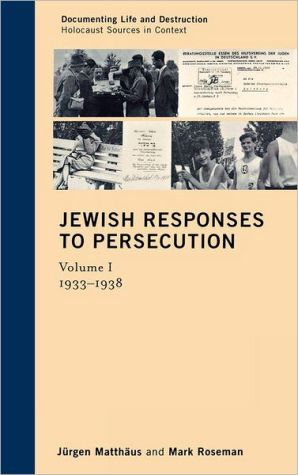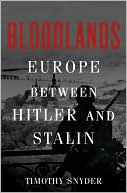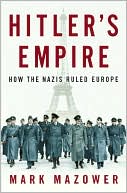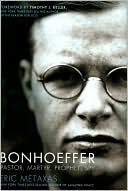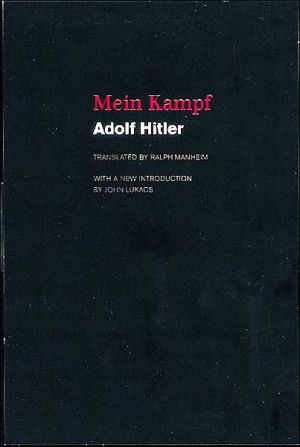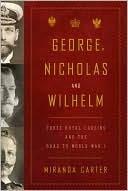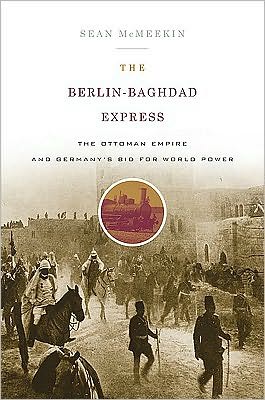Jewish Responses to Persecution, 1933-1946: Volume I, 1933-1938
Jewish Responses to Persecution, 1933–1946 offers a new perspective on Holocaust history by presenting documentation that describes the manifestations and meanings of Nazi Germany's "final solution" from the Jewish perspective. This first volume, taking us from Hitler's rise to power through the aftermath of Kristallnacht, vividly reveals the increasing devastation and confusion wrought in Jewish communities in and beyond Germany at the time. Numerous period photos, documents, and annotations...
Search in google:
Jewish Responses to Persecution, 1933-1946 offers a new perspective on Holocaust history by presenting documentation that describes the manifestations and meanings of Nazi Germany's _final solution_ from the Jewish perspective. This first volume, taking us from Hitler's rise to power through the aftermath of Kristallnacht, vividly reveals the increasing devastation and confusion wrought in Jewish communities in and beyond Germany at the time. Numerous period photos, documents, and annotations make this unique series an invaluable research and teaching tool. Co-published with the United States Holocaust Memorial Museum. Library Journal In this first volume of a series documenting the Jewish responses to Nazism and the Holocaust, Matthaus (director, applied research, Ctr. for Advanced Holocaust Study, United States Holocaust Memorial Museum) and Roseman (Jewish studies, Indiana Univ.) follow the major trends in Holocaust historiography in their chapter organization, covering everything from the rise of Nazism to survival strategies, immigration, and everyday life through the aftermath of Kristallnacht. Each chapter starts with background information; then each document is framed, in Talmudic style, by the editor's contextual information and commentary. Since many previous documentary collections focus on material generated by the Nazis, the Jews have often appeared as passive figures who went to their doom without apparent resistance. Recent research, however, has revealed that Nazi ideology was often implemented in a haphazard and contradictory manner, and this volume demonstrates how this affected the Jewish response. VERDICT These documents restore human agency to German Jews and reveal the multifaceted reactions to Nazism. The focus on contemporaneous sources avoids the trap common in much of the memoir literature that assumes Jews knew the end result of Nazi terror.—Frederic Krome, Univ. of Cincinnati Clermont Coll.
Introduction to the Jewish Responses to Persecution Series xiiiReader's Guide xxiiiAbbreviations xxvVolume Introduction; Jews and Other Germans before and after 1933 xxviiPart I The Battles of 1933 11 Confronting the Nazi Revolution 7Early Weeks 7Boycott 16Physical Threats 242 Exclusion and Introspection 33Embattled Identities 33Jewish Leadership and the "Jewish Sector" 453 Strategies for Survival 63Emigration, Hopes, and Realities 63Targets of the "People's Community" 74Taking Stock after One Year 84Part II Feeling One's Way: January 1934 to August 1935 954 Stretching the Limits of Influence 99Central and Regional Perspectives 99Constrained Communications 1085 Everyday Life in an Era of Uncertainty 117Bread on the Table 117Negotiating Public Spaces 123Jewish Children in the Schools of the "People's Community" 1326 Segregation and Exclusion: Spring and Summer 1935 145Reacting to Exclusion in the Spring of 1935 145Mounting Pressure, Changing Perspectives 154The Onslaught of the "People's Community" 162Part III Subjects Under Siege: September 1935 to December 1937 1777 The Nuremberg Laws and Their Impact 183Immediate Reactions after Nuremberg 183Could One Live in the New Germany? 1998 Bonds and Breaks with Germany 215Emigration Revisited 215Uneven Chances, Varied Fates 228Jewish Culture and Leisure in Nazi Germany 2369 Jewish Questions after Nuremberg 247Racists and Scholars 247How to Behave and Think As a Jew 251Contending with Crisis 259Part IV Dispossession and Disappearance: 1938 27110 "Model Austria" and Its Ramifications 275Anschluss and theJews 275Intensifying Racial Segregation 286Reverberations in the Reich 29011 Évian and the Emigration Impasse 305Escape Plans and Realities 305Defense without Weapons 324Refuge and Reflection 33112 "Kristallnacht" and Its Consequences 341Solidarity with the Deported 341Experiencing the Pogrom 349What Next? 367List of Documents 379Bibliography 397Glossary 409Chronology 437Index 453About the Authors 469
\ David CesaraniI have read Jewish Responses to Persecution Volume 1 from cover to cover, and I think it is a magnificent achievement. The selection of documents is astonishing in terms of the breadth and particular insight they offer. But the authors have also managed to select several times from the same sources, giving the reader a growing sense of familiarity—and empathy—with the authors. Combined with the wonderfully clear introductory pieces and linking commentary, this gives the volume the feel of an integrated history and even the quality of a novel. The reader begins to care about the witnesses and wonder what will happen to them next. It is truly a masterpiece.\ \ \ \ \ Christopher R. BrowningOne of the great challenges facing historians of any event or epoch is to recover the perceptions and uncertainties of people for whom what we know as the past was still an unknown and open-ended future. The singular achievement of this volume edited by Jürgen Matthäus and Mark Roseman is to place in the hands of historians, students, and general readers an extraordinary collection of documents that opens up the world of the 1930s as German Jews experienced it in all its urgency, confusion, disorientation, hope, and despair, not as we now make sense of it with the advantage of hindsight.\ \ \ Deborah E. LipstadtFor many years, the bulk of the research that has been done on the Holocaust focused on the actions of the perpetrators: what did they do and how did they do it? In recent years scholars have begun to redress this imbalance. Now their efforts will have a critically important resource on which to draw: the five volume series Jewish Responses to Persecution, 1933–1946. \ Drawing on diaries, letters, organizational archives, and a host of other sources it gives the victims a voice that, in too many other works, has been denied to them. While this first volume stands on its own as a book well worth reading, it also promises to become an invaluable aide to scholars, teachers, students, and all others who want to know more about 'the six million.' It is long overdue.\ \ \ \ \ \ Jewish Book WorldThis is an exceptionally well researched volume....Any reader seeking a glimpse of the mindset of German Jewry in the years leading up to the Final Solution will find the rich array of documents and correspondence in this volume to be of great interest. The authors, both distinguished Holocaust scholars, have made a major contribution to the field with the release of this painstakingly researched work. The documents and correspondence are assembled in a well-organized manner beginning with the rise of Nazism and ending with Kristallnacht and its consequences. The authors provide valuable context and explanation before and after the document entries. Each reader will bring their own specific interest to this reference work and use a given document or series of documents in support of a particular perspective on the evolution of the Shoah....Jewish Responses to Persecution provides powerful examples of denial and rationalization as defenses in the face of overt hatred, acts of violence and recurrent threats of genocide in the years 1933 to 1938....This book is laudable as a scholarly addition to the documentary history of the Holocaust as well as an unintended and tragic reminder of the mortal dangers that stem from a disbelieving, defenseless, and unarmed Jewish population facing genocidal anti-Semitism.\ \ \ \ \ CHOICEIn this first volume in a series, Matthäus (US Holocaust Memorial Museum; Atrocities on Trial, CH, Mar'09, 46-4064) and Roseman (Indiana Univ., Bloomington; The Wannsee Conference and the Final Solution: A Reconsideration, 2002) collect 200 documents that illustrate Jewish life in Germany under Nazi persecution prior to WW II. Following an introductory essay on Jews in Germany before 1933, the volume is organized into four chronological sections (e.g., 'Subjects under Siege: September 1935 to December 1937'), each of which has three chapters (e.g., 'Jewish Questions after Nuremberg'). Each section begins with a historical overview, and each chapter features a contextual overview. The documents (all translated into English) come from both published and unpublished sources and include excerpts from diaries, letters, government reports and contemporary newspaper articles and some photographs. Context and/or explanation is provided for each document, many of which pertain to ordinary people. A touching example comes from a 1935 Bar Mitzvah note from Max Rosenthal to his grandson Hans, in which Rosenthal wrote, 'Memories are the only paradise from which we cannot be expelled.' Other features include a list of abbreviations, bibliography, glossary, and chronology (1933-early 1939). Recommended.\ \ \ \ \ Holocaust and Genocide StudiesThis is a highly accessible collection of primary-source materials, unique in that the documents emanate from the German-Jewish victims themselves, and are presented within the historical context of the development of Nazi Jewish policy after 1933. Given the nature and quantity of the individual and institutional documents that the authors have assembled, this volume will provide scholars with invaluable materials for research projects on the Jewish victims of Nazi persecution. But its main value, and that of the four volumes that will follow, will be as a teaching resource especially for undergraduate and graduate seminars in Jewish history and the history of the Holocaust....The authors are to be congratulated for their document, and for their expert contextualization and annotation of the documents.\ \ \ \ \ ChoiceIn this first volume in a series, Matthäus (US Holocaust Memorial Museum; Atrocities on Trial, CH, Mar'09, 46-4064) and Roseman (Indiana Univ., Bloomington; The Wannsee Conference and the Final Solution: A Reconsideration, 2002) collect 200 documents that illustrate Jewish life in Germany under Nazi persecution prior to WW II. Following an introductory essay on Jews in Germany before 1933, the volume is organized into four chronological sections (e.g., 'Subjects under Siege: September 1935 to December 1937'), each of which has three chapters (e.g., 'Jewish Questions after Nuremberg'). Each section begins with a historical overview, and each chapter features a contextual overview. The documents (all translated into English) come from both published and unpublished sources and include excerpts from diaries, letters, government reports and contemporary newspaper articles and some photographs. Context and/or explanation is provided for each document, many of which pertain to ordinary people. A touching example comes from a 1935 Bar Mitzvah note from Max Rosenthal to his grandson Hans, in which Rosenthal wrote, 'Memories are the only paradise from which we cannot be expelled.' Other features include a list of abbreviations, bibliography, glossary, and chronology (1933-early 1939). Recommended.\ \ \ \ \ Library JournalIn this first volume of a series documenting the Jewish responses to Nazism and the Holocaust, Matthaus (director, applied research, Ctr. for Advanced Holocaust Study, United States Holocaust Memorial Museum) and Roseman (Jewish studies, Indiana Univ.) follow the major trends in Holocaust historiography in their chapter organization, covering everything from the rise of Nazism to survival strategies, immigration, and everyday life through the aftermath of Kristallnacht. Each chapter starts with background information; then each document is framed, in Talmudic style, by the editor's contextual information and commentary. Since many previous documentary collections focus on material generated by the Nazis, the Jews have often appeared as passive figures who went to their doom without apparent resistance. Recent research, however, has revealed that Nazi ideology was often implemented in a haphazard and contradictory manner, and this volume demonstrates how this affected the Jewish response. VERDICT These documents restore human agency to German Jews and reveal the multifaceted reactions to Nazism. The focus on contemporaneous sources avoids the trap common in much of the memoir literature that assumes Jews knew the end result of Nazi terror.—Frederic Krome, Univ. of Cincinnati Clermont Coll.\ \
